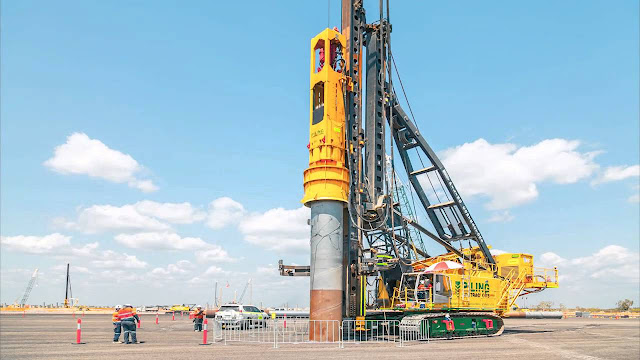Piling Machines: Foundation of Strong Structures
 |
| Piling Machines |
Piling machines are heavy-duty construction equipment used to install foundation piles or poles that transfer the load of a structure down through weak or unstable upper soil layers into stronger, deeper layers of soil or bedrock that can adequately support the structure. These machines play a vital role in facilitating the construction of high-rise buildings, bridges and other infrastructure projects.
Types of Piling Machines
There are different types of piling machines used for installing different
types of piles based on site conditions and load requirements. Some common
types are:
Impact Hammers: One of the most widely used piling machines, impact hammers
install concrete, steel or timber piles by repeatedly lifting a heavy hammer
and letting it drop onto the pile head, driving it deep into the ground. Piles
can be driven to depths of over 50 meters using impact hammers mounted
oncrawler cranes or truck-mounted platforms.
Vibratory drivers: For installing smaller diameter piles in loose or medium
dense soils, vibratory drivers are commonly used. They utilize rapidly
vibrating mechanical forces rather than impact to advance piles into the
ground. This causes less disturbance to surrounding soil particles.
Screw Piles: Screw pile drilling machines are best suited for very loose or
sandy soils where impact hammers may not work effectively. They install helical
piles or screw piles by rotating them like a screw into the ground using high
torque motors.
Auger Piling Machines: When installing large diameter bored piles, auger piling
machines are employed. They use auger attachment to bore holes of required
diameter into the ground and cast concrete or install casing pipes to form
piles. Continuous flight hollow-stem augers are common.
Key Components and Functions
All piling machines, regardless of type, consist of some common key components
that facilitate pile installation. These include:
- Powerful lifting cranes or hoists to raise and lower the piling hammer,
driver and pile sections.
- Lead systems to precisely guide piles as they are driven/installed downwards.
Complex marine leads are often used for offshore piles.
- Piling hammers/drivers - Main component that exerts force on pile head as per
pile type. Impactors, vibrators, rotators etc.
- Electronics and controls to automate/monitor installation processes like
downward movement, rotational speed, hammer energy etc.
- Diesel engines or electric motors provide power to operate various functions.
- Safety barriers, platforms and rigging for operators to work safely at
heights during piling operations.
Applications in Construction
Piling machines play a crucial role in constructing deep foundations for a wide
range of infrastructure including:
High-Rise Buildings: Skyscrapers require piles driven 50-100m deep to transfer
superstructure load to firm strata. Piling rigs efficiently install prestressed
concrete or steel H-piles.
Bridges: Foundation design of long-span bridges involves installation of large
diameter bored piles or pipe piles using auger machines near abutments and
piers.
Harbors and Jetties: Offshore marine structures need long reinforcement
concrete or tubular steel piles driven through water and unstable sediments
using powerful marine piling rigs.
Dams and Embankments: Sheet Piling
Machines are used to install interlocked steel piles around
construction sites to retain earth and control seepage during dam and
embankment construction.
Underground Structures: Diaphragm walling and secant pile wall techniques
employ specialized piling rigs and tools like cutter soil mixers to form
contiguous concrete or composite pile walls for deep basements, tunnels and
metro stations.
Benefits of Piling Machines
The use of advanced piling machines provides many advantages over manual pile
driving methods:
- Higher installation rates and productivity due to mechanized pile driving
operations.
- Consistent quality of installation with precise leads and automated driving
sequences.
- Ability to install a wide range of pile types - concrete, steel, timber,
screw, mini, bored, sheet etc.
- Piling to greater depths even in hard strata using high energy impact or
vibratory systems.
- Monitoring of installation parameters like blow counts, rotations, depths
helps foundation design.
- Safer working at heights with robust rigs, work platforms and fall protection
systems.
- Less ground vibration and noise pollution compared to conventional methods.
- Ability to install foundation support even in restricted access areas and
congested job sites.
With advanced technologies, modern piling machines have helped build some of
the world's tallest and most ambitious infrastructure projects. They will
continue playing a key role in supporting future construction of high-rise,
long-span and underground structures.
Get
more insights, on Piling
Machine
Check
more trending articles related to this topic:
Organic
Farming Market



Comments
Post a Comment